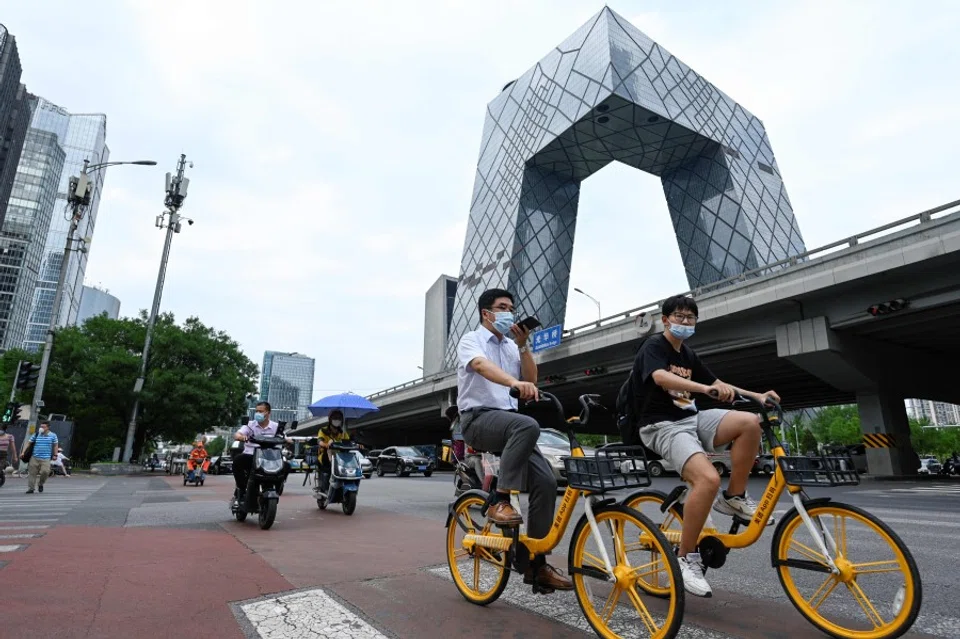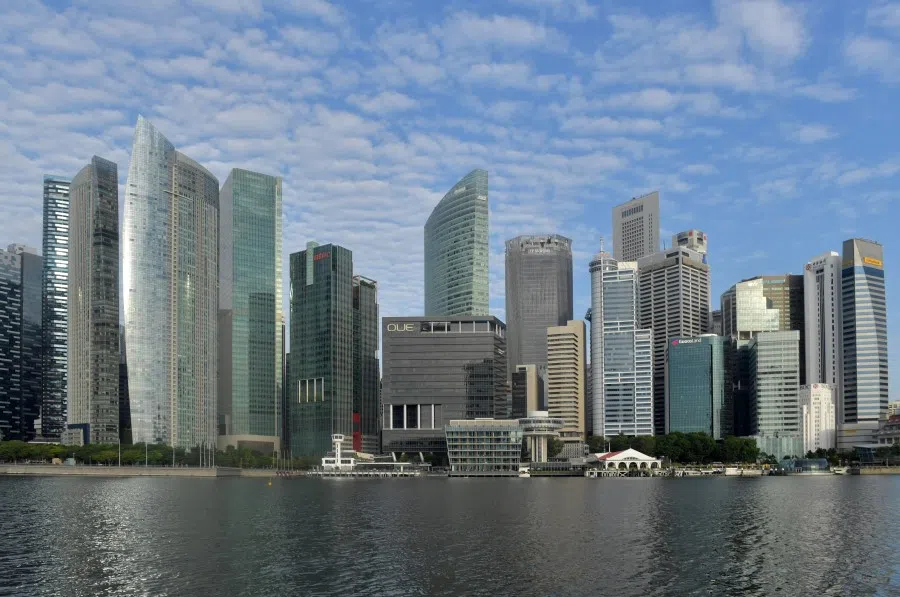From Singapore to China, data centre investments thriving amid challenges
Data centres have become a thriving sector in the Asia Pacific, with global companies setting up infrastructure in hotspots such as Singapore, Hong Kong and Sydney. Compared with traditional real estate assets, data centres promise higher returns on investment. However, developers will need to contend with rising energy costs and stricter regulations for greener developments.

(By Caixin journalists Yang Min, Niu Mu Jiang Qu and Zhou Wenmin)
Data centres are a hot ticket in the Asia Pacific, where investors are pouring billions of dollars into the industry. But the facilities' voracious appetite for electricity is posing a major hurdle for developers, who are facing both soaring energy prices and governments that are trying to wean themselves off of fossil fuels.
Higher sustainability requirements
Demand for data storage has rocketed as the pandemic has shifted working life online, increasing the use of cloud computing and creating a proliferation of data that needs to be stored and processed. A boom in data centre investment has followed but so has a need for power. In 2020, global data centre electricity usage was between 200 and 250 terawatt hours, around 1% of total electricity demand, according to the International Energy Agency.
New data centres will need to meet higher sustainability standards than existing sites, including the requirement of a power usage effectiveness (PUE) of no more than 1.3...

In Singapore, which is championing the development of such data centres, the industry's electricity use accounted for 5.3% of the city-state's total energy consumption in 2019, according to data from the Ministry of Communications and Information.
The Lion City also recently lifted a moratorium on new data centre construction, which had been in place since 2019. The move shows that data storage infrastructure is too important to miss out on, despite concerns that it will put a significant strain on the electricity grid.
But even as Singapore encourages the inception of new data centre projects, the government has said that it is looking for locations "that are best in class in terms of resource efficiency." New data centres will need to meet higher sustainability standards than existing sites, including the requirement of a power usage effectiveness (PUE) of no more than 1.3, reported the Business Times earlier this year. (PUE refers to the amount of power consumed by a data centre, divided by the amount of power used to operate the IT equipment at the site. A lower value represents higher efficiency.)
79% of respondents picked China as one of the top three countries they expect to see the biggest growth in investment over the next 24 months, followed by India and the US.
Focus on high quality projects
Hong Kong and the Chinese mainland are also supporting the rapid development of data centres, while rolling out similar environmental measures for the industry to contend with.
Beijing launched its so-called Eastern Data and Western Computing initiative earlier this year. The plan is to create a new computing network system that integrates data centres, cloud computing and big data, by taking advantage of western China's huge renewable energy resources to take in data from the eastern region, where most of the country's internet industry is based.
The initiative is a boon for data centre investors, but one that comes with limitations. As with Singapore, the focus is on high quality data centre projects that make use of renewable energy and new facilities will also need to have a PUE of 1.3 or lower, according to a three-year data centre construction guideline released by China's Ministry of Industry and Information Technology in July last year. The proposal comes alongside China's "dual carbon" pledge to peak carbon emissions by 2030 and to reach carbon neutrality by 2060.
And concerns around renewable power use go hand-in-hand with the issue of energy security, which is viewed as one of the most significant factors shaping data centre investment: 90% of equity investors, 89% of developers, and 85% of debt providers in the industry are willing to pay a premium to invest in a site with a good and cost-effective power supply, according to a June report by law firm DLA Piper, which surveyed 100 senior executives from the three groups.
The [Hong Kong] government estimated the territory will ultimately have 1.1 million square metres of land used for data centres by 2025.

Adding insult to injury, global gas and electricity prices have ballooned over the past 12 months, greatly increasing data centre operating costs. As a result, 98% of senior executives in the Asia Pacific are likely to pay a premium for energy security, the report shows. The willingness to pay a premium for energy security may be a result of rolling power outages in China and India in the second half of 2021, the law firm said.
Hong Kong, in contrast with its neighbours, is facilitating the construction of new data centres, despite its limited land resources and reliance on fossil fuels. The government last year rolled out a series of specific incentives for the industry, including designating land for data centre construction, which was then auctioned at a favourable price.
The government estimated the territory will ultimately have 1.1 million square metres of land used for data centres by 2025. It had around 779,000 square metres as of the first quarter of 2021, according to real estate services firm Cushman & Wakefield PLC.
China Mobile International Ltd. broke ground on a new 103,660 square metre project in December in Hong Kong's in New Territories region.
Rapid expansion
Although data centre investment has been mainly targeted in the US and Europe, the Asia Pacific region is expected to be the biggest source of future growth. According to the DLA Piper report, 79% of respondents picked China as one of the top three countries they expect to see the biggest growth in investment over the next 24 months, followed by India and the US.
The world's five top cloud service providers, Amazon Web Services, Microsoft's Azure, Alibaba, Tencent and Google Cloud, each have proprietary data centres in Singapore.

This shift towards Asia Pacific is driven by the rise of Chinese hyperscalers, including Alibaba Group Holding, Tencent Holdings and ByteDance. Hyperscaling is a method of quickly processing data that has been adopted by data centres and cloud service providers.
Major cloud service providers often build their own data centres - a strategy used to boost their product offerings in the face of increased competition. The world's five top cloud service providers, Amazon Web Services, Microsoft's Azure, Alibaba, Tencent and Google Cloud, each have proprietary data centres in Singapore.
Meanwhile, China-based GDS Holdings Ltd. is among dozens of data centre operators that have recently announced big investment plans in Southeast Asia. After entering that market in July 2021, the Nasdaq-listed company has launched three data centre projects in partnership with local firms in Malaysia and Indonesia, GDS chairman Huang Wei said in an interview with Caixin in May.
Bridge Data, a subsidiary of GDS rival Chindata Group Holdings Ltd., has four data centre projects in operation in Malaysia, Caixin has learned.
In 2021, companies spent an estimated US$73.7 billion in the Asia Pacific on data centre-related equipment and services, including IT infrastructures such as servers and additional expenses such as land costs, according to the consultancy Grand View Research. The region trails only North America, as the second largest market in the world. But the Asia Pacific market is expected to grow at a compound annual rate of 6%, compared with 5.3% for North America, from 2020 to 2027.
Given the possibility of double-digit returns, the industry has attracted a litany of developers, operators and investors in Asia.
Hot investment
Investment in the Asia Pacific market hit US$4.8 billion last year, more than the previous four years combined, according to a report by real estate services and investment firm CBRE.
Compared with traditional real estate assets, data centres have a much higher return on investment (ROI), said Li Xiang, a China-based researcher at Savills, a commercial real estate brokerage. Properties such as residential blocks, offices, shopping malls and logistics facilities earn an ROI from 2% to 6%, while data centres can offer up to 20%, according to Li.
The main reason for such high returns is that data centres have more added value than traditional property. Although data centres require spending on expensive equipment and long-term maintenance, tenants usually sign longer leases, said Jin Lianzheng of Cushman & Wakefield, a manager of the firm's data centre business in China.
Given the possibility of double-digit returns, the industry has attracted a litany of developers, operators and investors in Asia. Among them is global private equity fund Warburg Pincus LLC, which in 2017 set up arm Princeton Digital Group in Singapore with a focus on the investment, development, and operation of internet infrastructure. The subsidiary has more than 20 data centre projects in its portfolio.
Real estate managers are also taking to the sector, to diversify housing and commercial property-heavy portfolios. GLP, a Singapore-based real estate logistics company, began investing in data centres in 2018. Over the next five years, the firm plans to put around US$12 billion to work building new facilities in Japan's Greater Tokyo and Greater Osaka regions. The sites will have capacities of up to 900MW.

Asia has become the second most favourable destination for data centre investment globally. Of the top ten hotspots in 2022, three are in Asia - Sydney, Hong Kong and Singapore - according to a report by Cushman & Wakefield. The report ranks data centre competitiveness by accessing data centre markets across the globe within 13 categories such as market size, government incentives and power cost.
But investors are also being lured by the region's long-term need for data centre capacity, which is growing in tandem with the increasing internet penetration in developing countries and the widespread digitalisation of traditional businesses.
As a result, emerging markets including Vietnam, Malaysia and Indonesia are also seeing demand for data centres surge, said Xiao Lianghui, a Hong-Kong-based manager at Cushman & Wakefield.
This article was first published by Caixin Global as "In Depth: Asia's Data Center Developers Grapple With Green Restrictions, Energy Security". Caixin Global is one of the most respected sources for macroeconomic, financial and business news and information about China.
Related: China's push towards green energy accelerated by security concerns, What can Singapore learn from China?, China's cloud war: Huawei leading the three-cornered fight? [Part 1], China's cloud war: Tencent and Alibaba up their game as cloud giants eye world markets [Part 2], How enterprises survive in China's smart cities

![[Big read] Paying for pleasure: Chinese women indulge in handsome male hosts](https://cassette.sphdigital.com.sg/image/thinkchina/c2cf352c4d2ed7e9531e3525a2bd965a52dc4e85ccc026bc16515baab02389ab)



![[Big read] How UOB’s Wee Ee Cheong masters the long game](https://cassette.sphdigital.com.sg/image/thinkchina/1da0b19a41e4358790304b9f3e83f9596de84096a490ca05b36f58134ae9e8f1)